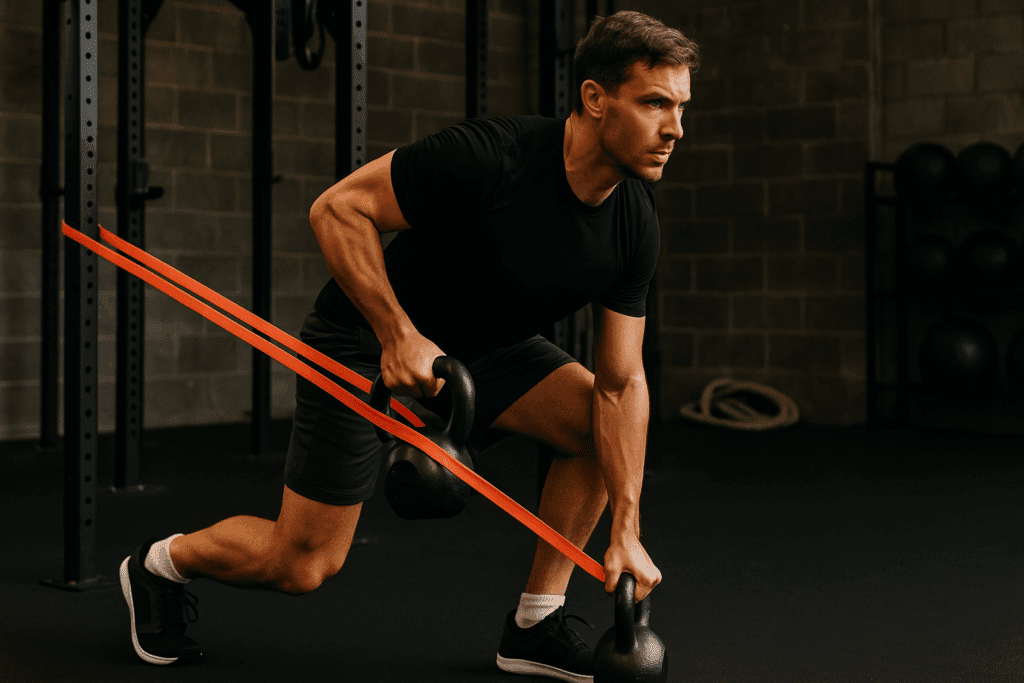Understanding the Foundations: What Is Endurance and How It Relates to Stamina
Endurance and stamina are two concepts frequently used interchangeably in the fitness world, but they are not identical. To truly improve athletic endurance, one must first understand the nuance behind these terms. The endurance meaning in physical fitness refers to the body’s ability to sustain prolonged activity over time, especially during cardiovascular or aerobic exercises. Stamina, on the other hand, refers more specifically to the mental and physical capacity to sustain peak performance or effort for a set period. While stamina vs endurance may sound like a purely semantic distinction, in practice it matters greatly for developing targeted workout strategies.
You may also like: How to Increase Stamina and Endurance Naturally: Smart Training Tips and Nutrition Habits That Support Cardiovascular Fitness
The difference between stamina and endurance lies in the nature of effort and the system being taxed. Muscle endurance vs stamina, for example, highlights that muscle endurance is about sustaining muscular activity, such as repeating a movement or maintaining posture, while stamina leans into overall vitality and intensity. The question “Is stamina and endurance the same?” becomes increasingly important for athletes seeking to optimize their routines. By understanding the unique demands of endurance versus stamina, trainers and athletes can create tailored regimens that build the right kind of resilience in both body and mind.
From a physiological standpoint, endurance training often involves increasing the efficiency of the cardiovascular system and mitochondria in the muscles, enabling greater oxygen uptake and energy production. In contrast, stamina enhancement focuses on energy conservation, mental toughness, and metabolic adaptations that support short-to-medium bursts of high-intensity effort. Knowing this, athletes aiming to improve athletic endurance should consider both stamina and endurance training techniques, recognizing that together they build the foundation for peak physical performance.

Endurance Fitness Meaning: Why It Matters for Long-Term Performance
Understanding the endurance fitness meaning in a practical context is key to building a sustainable fitness routine. Endurance fitness refers to the physiological capacity to perform activities such as running, swimming, or cycling over extended periods without succumbing to fatigue. This form of fitness is not only critical for long-distance athletes but also beneficial for everyday functionality. The concept of building endurance meaningfully involves more than just repetitive motion—it requires strategic progression, structured recovery, and metabolic conditioning.
One of the most misunderstood elements in training is the assumption that endurance endurance—a phrase that humorously reflects the repetition within endurance training itself—is about doing more rather than doing better. True endurance is cultivated by training smart, not merely hard. For example, an individual might log hours of jogging each week, but if they ignore progressive overload or neglect cross-training, their development will plateau. The best endurance training includes variation, active recovery, and nutrition to fuel long-duration performance.
Moreover, endurance meaning in physical fitness also encompasses mental endurance. The ability to sustain concentration, overcome discomfort, and adhere to a disciplined routine directly contributes to long-term athletic development. Whether you’re competing in marathons or simply trying to stay active into your later years, cultivating endurance fitness supports a healthy heart, strong lungs, and efficient metabolism. That is why building endurance meaningfully requires commitment to both physiological and psychological growth.

How Much Does Physical Stamina Make a Difference in Athletic Performance?
The question of how much does a physical stamina make in the realm of athletic performance is more than rhetorical. The answer lies in the observable and measurable advantages that well-trained athletes exhibit over time. Physical stamina allows athletes to extend their performance thresholds, recover more rapidly between sessions, and handle higher volumes of training without injury. The significance of stamina and endurance training becomes clear when examining the consistent gains in speed, agility, and power among athletes who prioritize it.
Stamina is not a trait exclusive to elite athletes. Anyone can learn how to gain stamina at home through structured routines that include aerobic and anaerobic exercises, bodyweight resistance movements, and mobility work. These foundational activities allow the body to adapt incrementally to increased demand, building both cardiovascular capacity and muscular resilience. The benefits become even more pronounced when this training is supported by proper sleep, hydration, and a diet rich in complex carbohydrates and lean protein.
Importantly, the difference between stamina and endurance becomes even more distinct in sports-specific contexts. For example, a boxer may have excellent stamina to maintain high energy bursts during a match, whereas a cyclist might need endurance to sustain a long-distance race. Both elements are crucial, and training plans must reflect the athlete’s specific demands. Therefore, understanding the balance between strength and stamina training helps bridge the gap between raw effort and calculated performance.

Best Stamina Workouts to Improve Athletic Endurance Naturally
Choosing the best stamina workouts is essential for athletes and fitness enthusiasts seeking to improve athletic endurance without relying on synthetic aids or overtraining. These workouts must be dynamic, adaptable, and aligned with the individual’s current fitness level. Interval training, for instance, is one of the best exercises to build stamina. It alternates between periods of high-intensity effort and recovery, which teaches the body to tolerate and recover from exertion more effectively. This form of training increases both aerobic and anaerobic thresholds.
Similarly, circuit training provides a structured yet intense approach to stamina and endurance training. It incorporates a variety of bodyweight and resistance-based exercises performed in quick succession. This not only keeps the heart rate elevated but also recruits multiple muscle groups simultaneously, offering a comprehensive workout that builds strength and cardiovascular health. When done consistently, these sessions dramatically enhance the body’s ability to resist fatigue and sustain effort over time.
Another often overlooked yet highly effective option is steady-state cardio, such as long-distance running, swimming, or cycling at a moderate pace. This approach allows the body to adapt to prolonged energy expenditure and teaches the muscles to become more efficient at using oxygen. For individuals wondering how to increase stamina at home, simple routines like jogging in place, stair climbing, and shadowboxing offer practical, low-equipment alternatives. By rotating through these stamina-focused workouts and ensuring adequate recovery, athletes can achieve measurable improvements in performance.

Understanding Endurance vs Stamina Examples in Real-Life Training
To truly grasp the difference between endurance vs stamina, it helps to observe how these concepts play out in various physical contexts. Take the example of a marathon runner versus a CrossFit athlete. The marathon runner relies on endurance to maintain a consistent pace over 26.2 miles, a feat requiring sustained energy output and cardiovascular efficiency. The CrossFit athlete, on the other hand, might perform short bursts of explosive activity over a much shorter duration but still needs the stamina to repeat these efforts across a competition or training session.
This contrast between endurance vs stamina examples highlights how each concept manifests differently depending on the sport or physical goal. A swimmer training for a 1,500-meter race develops endurance through interval swimming and aerobic conditioning. In contrast, a soccer player needs stamina to make repeated sprints, direction changes, and tackles throughout a match. Both require intense preparation, but the pathways to success diverge.
For those seeking clarity on endurance versus stamina, understanding their application to specific scenarios is vital. This insight can shape the design of more efficient training programs. Instead of blindly mimicking popular fitness routines, athletes can assess whether their goals align more with developing prolonged output (endurance) or quick recovery between efforts (stamina). Incorporating this knowledge ensures that every minute of training contributes to the desired outcome.

How to Improve Stamina at Home Without Expensive Equipment
The good news for fitness enthusiasts and beginners alike is that understanding how to improve stamina at home is not only possible but often more sustainable than relying solely on gym-based routines. Home workouts offer the flexibility and privacy that many people need to remain consistent, and they allow for creative exercise variations that target both muscular and cardiovascular systems. Whether it’s bodyweight squats, burpees, jumping jacks, or stair climbs, these movements can all form the foundation for a stamina-focused training routine.
A well-structured at-home plan begins with aerobic conditioning. This can include shadowboxing, dancing, or jogging in place for set intervals. These activities elevate the heart rate, stimulate lung capacity, and improve circulation. Over time, these effects translate to better athletic performance and increased energy during daily tasks. For those wondering how to gain stamina at home effectively, the answer lies in consistency, progressive overload, and adequate rest.
Equally important is including resistance training in your at-home routine. This could involve bodyweight exercises like push-ups, lunges, or planks, which enhance muscle endurance and strength. When paired with brief cardio intervals, such as jump rope or high knees, these routines become powerful tools for stamina and endurance training. By sticking to a varied and challenging schedule, it becomes possible to dramatically improve athletic endurance with minimal equipment or cost.

Strength and Stamina Training: Why Resistance Matters for Endurance
While many people associate endurance solely with cardiovascular activity, strength and stamina training play an equally critical role in overall fitness. Building muscular strength supports the skeletal structure, improves joint stability, and enhances movement efficiency—all of which are essential for sustained physical activity. The synergy between strength and endurance means that a body capable of exerting force repeatedly with minimal fatigue is one better suited for long-duration performance.
Functional resistance training methods such as kettlebell circuits, resistance band routines, and bodyweight strength workouts allow for the dual development of stamina and muscle resilience. By focusing on high-rep, low-to-moderate weight movements with minimal rest, these workouts build muscle endurance while keeping the heart rate elevated. This integration creates an ideal environment for improving both anaerobic and aerobic capacity.
Furthermore, strength and stamina training addresses muscle imbalances and postural weaknesses that can hinder endurance performance. It enables athletes to maintain proper form under fatigue, reducing the risk of injury and enhancing biomechanical efficiency. The more robust the musculoskeletal system, the more effectively it can handle prolonged or repetitive stress. As such, no athlete should overlook the role of resistance in building true athletic endurance.
Best Endurance Training Strategies for Sustainable Gains
Designing the best endurance training plan requires careful consideration of frequency, intensity, and variety. A common mistake among fitness enthusiasts is focusing exclusively on one modality, such as running, while neglecting other components like strength, mobility, and recovery. Balanced programming is essential to avoid overtraining and burnout. Effective plans typically combine long-duration aerobic workouts, moderate-intensity intervals, strength sessions, and active recovery days.
Cross-training is a key element in avoiding stagnation. Alternating between cycling, swimming, rowing, and running not only challenges different muscle groups but also minimizes repetitive strain. Incorporating mobility exercises like yoga or dynamic stretching improves circulation and joint health, both of which are crucial for long-term performance. This holistic approach maximizes results and promotes greater adaptation across multiple physiological systems.
Tracking progress is another vital strategy. Whether using a fitness app, wearable technology, or a simple journal, monitoring heart rate zones, recovery metrics, and performance benchmarks provides critical feedback. It allows for timely adjustments in training load and identifies early signs of overreaching. By prioritizing recovery, nutrition, and proper planning, athletes can ensure their stamina and endurance training yields consistent, long-term benefits.

Reflecting on Progress: How to Sustain Motivation While Building Endurance
Maintaining motivation in any long-term training plan is one of the most overlooked aspects of fitness success. To build stamina and improve athletic endurance naturally, it helps to celebrate small victories and milestones along the way. Whether it’s shaving seconds off a run time, completing more reps, or simply feeling less winded during daily activities, recognizing progress keeps morale high. Psychological endurance, much like physical endurance, improves with consistent positive reinforcement.
Variety in training also supports motivation. Changing your environment, experimenting with new workout formats, or introducing music and social elements can keep routines from becoming monotonous. Setting short-term and long-term goals creates a roadmap that guides your development and makes abstract objectives more tangible. This structure helps align daily habits with broader aspirations, reducing the likelihood of burnout.
Building a community, whether online or in-person, enhances accountability and provides a support network. Sharing achievements, challenges, and tips with others fosters a sense of camaraderie that can be deeply motivating. Finally, understanding the science behind training, from the endurance fitness meaning to the difference between stamina and endurance, equips you with the knowledge needed to make empowered, intentional choices throughout your journey.
Frequently Asked Questions: Stamina and Endurance Training
1. Can psychological resilience impact how much physical stamina you build? Absolutely. While most training programs focus heavily on physical activity, psychological resilience is a powerful component in the ability to improve athletic endurance. Mental toughness supports consistency, helps manage discomfort during prolonged effort, and keeps motivation high even when physical progress feels slow. The ability to push past perceived limits often distinguishes elite performers from casual exercisers, and this mental edge enhances both stamina and endurance training outcomes. In fact, developing mental fortitude may be just as critical as selecting the best exercise to build stamina, particularly for endurance athletes competing at high levels.
2. How can you adapt strength and stamina training to accommodate aging or injury? Strength and stamina training can and should be adapted for individuals dealing with aging-related changes or recovery from injury. Low-impact exercises like resistance band workouts or aquatic training can provide joint-friendly alternatives while still targeting muscle endurance vs stamina. Periodization strategies—cycling through intensity and volume over time—can also prevent overuse injuries while still supporting the endurance fitness meaning for long-term success. Additionally, incorporating mobility and stability exercises helps protect vulnerable areas, making stamina and endurance training both safer and more sustainable. With proper adaptation, it is entirely possible to improve athletic endurance even in the presence of limitations.
3. What is the best way to track progress when building endurance at home? When learning how to improve stamina at home, tracking progress is essential. Apps and wearable fitness trackers can monitor heart rate zones, VO2 max estimates, and recovery time, all of which are indicators of improved endurance. However, simple tools like journals also work well. Record how long you can sustain a workout, note perceived exertion levels, and track how quickly your heart rate returns to baseline. These indicators can show whether your approach to how to gain stamina at home is effective and help identify plateaus where training may need to be adjusted.
4. Can improving breathing techniques help with endurance versus stamina development? Yes, refining breathing techniques is one of the most overlooked ways to enhance endurance endurance. Controlled breathing increases oxygen efficiency and can reduce the sensation of fatigue, which is especially useful during high-volume or long-duration workouts. Whether your focus is on the difference between stamina and endurance or mastering both simultaneously, diaphragmatic breathing can delay the onset of muscle fatigue and regulate heart rate more effectively. This technique is particularly helpful in endurance sports like swimming and running, where breath control directly influences performance. Thus, breathwork supports the broader endurance meaning in physical fitness by optimizing internal systems.
5. How does nutrition play a role in stamina vs endurance gains? Nutrition is a key component of any training plan, especially when distinguishing between stamina vs endurance. Endurance efforts often rely on slow-burning fuel sources like complex carbohydrates and fats, while stamina-based efforts may require quicker energy from simpler carbs. Protein aids in muscle repair, which is vital for both types of training. Hydration and electrolyte balance also significantly affect how much does a physical stamina make in day-to-day performance. Understanding these nutritional differences ensures that your stamina and endurance training is supported by the fuel your body actually needs.
6. Are there differences in training approach for sports-specific endurance versus stamina? Definitely. Sports-specific training highlights the endurance vs stamina examples across different disciplines. A tennis player might train for stamina to handle short, high-intensity rallies, while a long-distance cyclist trains primarily for endurance to maintain effort over hours. Tailoring your training based on these distinctions helps align workout structure with competitive needs. For example, sprint intervals may be the best exercise for stamina in contact sports, while tempo runs or long-distance swims better support endurance development. Understanding what is endurance in your specific sport helps you customize an effective program.
7. How can busy professionals integrate endurance fitness into daily routines? Busy individuals often struggle to carve out time for training, but knowing how to increase stamina at home can make a big difference. Micro-workouts, such as 10-minute high-intensity circuits or brisk walks during lunch breaks, can build toward broader endurance goals over time. Integrating bodyweight movements between tasks is a creative solution to keep stamina and endurance training alive in a packed schedule. Because endurance fitness meaning extends beyond competitive sports to general vitality, even small efforts matter. Over time, these minor adjustments can yield significant gains in both energy levels and physical capability.
8. How do hormonal changes affect stamina and endurance capacity? Hormonal fluctuations, such as those related to aging or stress, can influence the body’s capacity for building endurance meaningfully. Cortisol, testosterone, and thyroid hormones all affect muscle metabolism, energy regulation, and recovery. Chronic stress can lead to elevated cortisol, which hinders recovery and lowers training output, directly impacting how to gain stamina at home or elsewhere. Hormonal assessments and recovery protocols are increasingly popular tools among elite athletes seeking to improve athletic endurance without overtraining. Understanding these biological shifts allows individuals to adjust their approach and optimize training based on their unique physiology.
9. What role does sleep play in stamina and endurance development? Sleep is often considered the “silent partner” in stamina and endurance training. During sleep, the body repairs tissue, consolidates learning, and rebalances hormone levels—all essential processes for those wondering how to improve stamina at home. Quality sleep supports muscle recovery, enhances glycogen storage, and even improves decision-making under physical stress. Whether the goal is mastering endurance meaning in physical fitness or simply sustaining longer workouts, adequate rest ensures the body is primed for optimal performance. Ignoring this aspect can undermine the benefits of even the best endurance training routines.
10. How can someone avoid burnout while pursuing the best stamina workouts? Burnout is a common risk for individuals overly focused on results without considering recovery or variation. To prevent it, incorporate rest days, active recovery, and mental resets into your plan. Rotating between strength and stamina training, as well as cross-training with different cardio formats, prevents physical and psychological fatigue. Recognizing the signs of overtraining—such as poor sleep, irritability, and stalled progress—helps athletes course-correct before long-term damage occurs. In pursuing the best stamina workouts or the best endurance training methods, it’s crucial to embrace balance as part of the overall strategy for longevity and performance.
Conclusion: Mastering Stamina and Endurance Training for Lasting Performance
The pursuit of improved athletic performance is a multifaceted journey that hinges on understanding the interplay between endurance and stamina. From recognizing the endurance meaning in physical fitness to exploring real-world endurance vs stamina examples, athletes must appreciate the unique demands of each concept. Effective training is not about doing more, but doing better—combining aerobic conditioning, resistance work, and mental resilience to build a body and mind capable of going the distance.
Whether your goal is to understand how to gain stamina at home or to design the best endurance training regimen, success lies in a balanced, personalized approach. By focusing on varied, evidence-based workouts and integrating recovery, nutrition, and progress tracking, you can dramatically improve athletic endurance without compromising well-being. Embracing the foundational difference between stamina and endurance empowers athletes at every level to train smarter, perform longer, and live healthier.
Ultimately, stamina and endurance training is not just for competitive athletes—it’s a lifelong investment in health, vitality, and performance. With the right strategies and a commitment to consistency, anyone can cultivate the strength and resilience needed to thrive in both sport and life.
Was this article helpful? Don’t let it stop with you. Share it right now with someone who needs to see it—whether it’s a friend, a colleague, or your whole network. And if staying ahead on this topic matters to you, subscribe to this publication for the most up-to-date information. You’ll get the latest insights delivered straight to you—no searching, no missing out.

